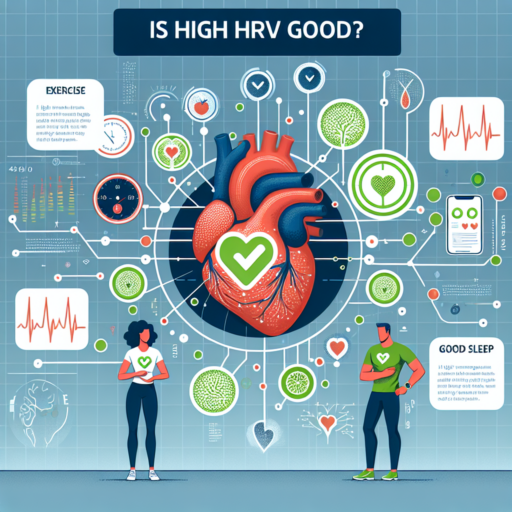What Is HRV and Why It Matters After Exercise?
Heart Rate Variability (HRV) is a critical, yet often overlooked, aspect of our physiological wellbeing, especially in relation to exercise. HRV refers to the variation in the time interval between consecutive heartbeats. Contrary to what some might think, a healthy heart does not beat with the regularity of a metronome; rather, it adjusts its rhythm based on the body’s immediate needs, environmental factors, and overall health. This variability is a sign of a robust and responsive cardiovascular system, capable of efficiently managing stress, fatigue, and recovery processes.
After participating in physical activities, understanding and monitoring your HRV can provide insightful data regarding your body’s recovery state and readiness for future workouts. A higher HRV indicates a relaxed, responsive state conducive to recovery, suggesting that the body is handling stress well and can adapt to further challenges. Conversely, a lower HRV post-exercise can signal overtraining, insufficient rest, or underlying health issues, guiding individuals to modify their fitness routines and recovery strategies for optimal health and performance gains.
Furthermore, HRV is gaining momentum as a pivotal metric in personalized fitness and wellness plans. Athletes and fitness enthusiasts alike are leveraging HRV measurements to tailor their training intensities, rest days, and nutritional intake, ensuring that every aspect of their regimen is aligned with their body’s current capacity for stress and recovery. This bespoke approach to training not only heightens performance but also significantly reduces the risk of injury, burnout, and chronically low HRV levels associated with long-term health complications.
The Impact of Different Types of Exercise on HRV
Understanding the impact of different types of exercise on Heart Rate Variability (HRV) is crucial for optimizing cardiovascular health and fitness strategies. Exercise, in its myriad forms, exerts varying effects on HRV, which indicates the activity of the autonomic nervous system and overall heart health. While aerobic exercises are known for their ability to enhance HRV by improving heart rate dynamics, the influence of anaerobic and strength training exercises presents a complex scenario worth exploring.
Aerobic Exercises such as running, cycling, and swimming are highly regarded for their positive impact on HRV. This form of physical activity enhances parasympathetic activity, leading to an improved HRV score, which is indicative of a healthy, responsive cardiovascular system. Regular engagement in aerobic exercises can significantly improve one’s ability to manage stress, recover from intensive physical activities, and maintain an optimal heart function.
Anaerobic and Strength Training Exercises, on the other hand, have a distinctive effect on HRV. Initially, intense workouts can lead to a temporary decrease in HRV, reflecting the stress placed on the body. However, consistent training in these disciplines can result in an overall increase in HRV over time. This suggests that while anaerobic and strength training exercises might stress the heart in the short term, they contribute to cardiovascular resilience and adaptability in the long run.
How To Measure Your HRV After Exercise
Understanding your Heart Rate Variability (HRV) after exercise can be an invaluable tool in assessing your recovery status and overall cardiovascular health. HRV refers to the variation in the time interval between heartbeats, an indicator of your autonomic nervous system’s (ANS) flexibility and a marker for your body’s ability to adapt to stress, both physical and emotional.
Step-by-Step Guide to Measuring HRV
Measuring your HRV post-exercise involves a simple process, but it requires consistency and accuracy for effective tracking over time. First, you’ll need a reliable HRV monitor or a heart rate monitor that includes HRV metrics. Wear the device according to the manufacturer’s instructions and ensure that you measure at the same time each day, preferably in the morning before engaging in any strenuous activity. This helps in attaining a consistent baseline from which to monitor changes. It’s also beneficial to remain motionless and breathe normally during measurements to avoid skewing the results.
Understanding Your HRV Data
Once you have your HRV data, interpreting it accurately is key to leveraging this information for your health and fitness goals. A higher HRV signifies a well-rested, more resilient body, while a lower HRV can indicate fatigue or stress. However, it’s essential to understand that daily fluctuations are normal and should be considered alongside factors such as emotional stress, sleep quality, and physical activity levels. Tracking these trends over time can help you identify patterns and make informed decisions about your training intensity, recovery strategies, and overall lifestyle adjustments.
Remember, the goal of measuring HRV after exercise is not to achieve a ‘perfect’ score but to understand your body’s reactions and recovery needs better. Consistency in measurement and analysis will provide the most accurate insights, enabling a tailored approach to your training and recovery programs.
Improving Your Post-Exercise Recovery Through HRV Tracking
Understanding and implementing effective strategies for post-exercise recovery is pivotal for athletes and fitness enthusiasts alike. One advanced method gaining popularity is Heart Rate Variability (HRV) tracking. HRV offers insightful data into the state of your autonomic nervous system, enabling you to personalize recovery protocols. By tracking the time gap between your heartbeats rather than the heart rate itself, HRV provides a nuanced view of your recovery status, making it a crucial tool for enhancing your training regimen.
Utilizing HRV tracking tools can significantly impact how quickly and effectively your body recuperates after strenuous activities. These tools range from wearable technology to smartphone apps, each offering various metrics to help you understand your body’s readiness for further training. By monitoring changes in your HRV, you can gauge if your body is under stress, overtrained, or has recovered, allowing for adjustments in your training intensity and duration. This personalized approach aids in preventing injuries and ensuring that you are training at an optimal level.
Implementing HRV tracking into your recovery process involves understanding your baseline measurements and observing the fluctuations over time. These variations in HRV can guide you in optimizing your recovery strategies, such as adjusting sleep patterns, nutrition, hydration, and stress management techniques. Embracing a holistic approach to recovery, informed by HRV data, can lead to improved performance, better health outcomes, and a more balanced training cycle.
Optimal HRV Ranges After Exercise for Different Fitness Levels
Understanding the optimal Heart Rate Variability (HRV) ranges after exercise can significantly influence how individuals plan their recovery and track fitness improvements. HRV measures the variation in time between each heartbeat, reflecting the body’s ability to respond to stress, exercise, and disease. Different fitness levels, from beginners to advanced athletes, exhibit distinct HRV patterns post-exercise due to variations in their body’s adaptability and recovery mechanisms.
Beginner Fitness Levels
For individuals at beginner fitness levels, HRV may initially decrease as the body adapts to new stressors introduced by exercise. It’s essential to monitor these changes closely; an optimal HRV range for beginners post-exercise should gradually return to baseline within 24 to 48 hours. This reflects proper recovery and adaptation to training stimuli. If the HRV fails to return to its norm or significantly drops and stays lower, this might indicate excessive physical stress or inadequate recovery.
Intermediate Fitness Levels
As fitness improves, the body becomes more efficient at handling and recovering from exercise-induced stress. Individuals at an intermediate level should observe less dramatic fluctuations in HRV after training sessions, with a quicker return to baseline values often within 24 hours. The optimal HRV range post-exercise for this group may show slight increases over baseline, indicating enhanced resilience and cardiovascular efficiency. Monitoring these subtle changes helps in adjusting training intensity and recovery practices to foster further fitness improvements.
Advanced Fitness Levels
Advanced athletes exhibit a high level of cardiovascular fitness and autonomic nervous system balance, reflecting in their HRV scores. The optimal HRV range after exercise for this group is characterized by a quick rebound to baseline or elevated levels, usually within a few hours post-exercise. It signifies superior recovery capabilities and an efficient stress response mechanism. Advanced athletes often use HRV trends to fine-tune their training regimes, focusing on maximizing performance while preventing overtraining and ensuring adequate recovery.
The Role of HRV in Identifying Overtraining and Under-recovery
The significance of Heart Rate Variability (HRV) is increasingly acknowledged in the realms of sports science and personal fitness for its adeptness at flagging the onset of overtraining and under-recovery states in athletes and fitness enthusiasts alike. HRV, representing the time variation between heartbeats, offers an insightful glimpse into the autonomic nervous system’s responsiveness to stress, physical exertion, and recovery processes.
Overtraining is a condition where the intensity or volume of exercise surpasses the body’s recovery capacity, leading to a decline in performance and potentially increased risk of injury. Conversely, under-recovery occurs when the body does not have adequate time or resources to fully recuperate between training sessions, impairing performance and well-being. By monitoring fluctuations in HRV, individuals and coaches can discern subtle cues that signal these detrimentally imbalanced states.
HRV serves as a meticulous metric that not only helps in early detection of overtraining and under-recovery but also in fine-tuning training regimens to harmonize with the body’s current recovery status. By observing HRV trends over time, it’s possible to make informed decisions about adjusting training intensity, volume, and rest periods, ensuring a tailored approach that fosters optimal performance and health.
Interpreting HRV After Exercise: What Your Numbers Mean
Certainly! Below is the content focused on interpreting HRV (Heart Rate Variability) after exercise, structured to be optimized for SEO.
Understanding your Heart Rate Variability (HRV) after exercising can provide insightful data about your recovery state and overall cardiovascular health. HRV measures the variation in time intervals between heartbeats, serving as a critical indicator of your autonomic nervous system’s balance. A high HRV can be synonymous with good heart health and a robust autonomic nervous system, while a lower HRV may indicate stress, fatigue, or underlying health issues. After exercise, interpreting these numbers becomes crucial to optimizing recovery and enhancing performance.
After engaging in physical activity, it’s natural for HRV scores to decrease temporarily, reflecting the body’s need to recover. However, the speed and efficiency of your HRV returning to baseline or improving can reveal much about your fitness level and resilience. Various factors influence post-exercise HRV, including the type, duration, and intensity of the workout. Importantly, consistency in measurement is key to accurately interpreting changes over time, ideally measuring HRV at the same time each day for the most reliable insight.
Adjusting your training based on HRV can help prevent overtraining and ensure adequate recovery. If your HRV shows a notable decline following a workout, this could be a sign that your body needs more rest. Conversely, an improvement or stable HRV post-exercise suggests you are well-recovered and can handle your current training load. Paying attention to these subtle cues, alongside other factors like sleep, nutrition, and stress levels, empowers athletes to optimize their training schedules for better performance and health outcomes.
Remember, HRV is a complex metric influenced by many variables, and while it offers valuable insights, it should be considered alongside other indicators of fitness and wellness.
No se han encontrado productos.
Tips to Improve Your HRV for Better Performance and Recovery
Improving your Heart Rate Variability (HRV) can play a significant role in enhancing your athletic performance and recovery. A higher HRV suggests a healthy, responsive cardiovascular system, whereas lower HRV can indicate stress, fatigue, or overtraining. Here are essential strategies to boost your HRV for better physical outcomes.
Regular Physical Activity
Engaging in consistent, moderate exercise is one of the most effective ways to improve your HRV. Activities like walking, jogging, swimming, or cycling can significantly enhance your cardiovascular system’s efficiency. However, balance is key as excessive training without adequate rest can lead to decreased HRV.
Optimize Sleep Quality
Quality sleep is paramount for recovery and HRV improvement. Aim for 7-9 hours of uninterrupted sleep per night, maintaining a consistent sleep schedule. Limit exposure to blue light from screens before bed, as it can disrupt your sleep cycle. Investing in a comfortable, supportive mattress and minimizing noise and light pollution in your bedroom can also promote deeper sleep.
Stress Management Techniques
Chronic stress negatively affects your HRV. Incorporating stress management techniques like deep breathing exercises, yoga, or meditation can help calm your mind and body. Finding hobbies that relax you and dedicating time to them regularly can also contribute to improved HRV and overall well-being.
Comparing HRV Trends: Rest Days vs. Exercise Days
Understanding the dynamics between HRV (Heart Rate Variability) trends during rest days and exercise days can offer valuable insights into our body’s recovery state and readiness for physical activities. HRV, a measure of the variation in time between each heartbeat, is widely regarded as a key indicator of autonomic nervous system function and overall heart health. This discussion explores the contrasting HRV patterns observed during days of rest compared to those involving exercise.
On rest days, HRV trends typically indicate higher values, suggesting a state of reduced stress and increased recovery. These days allow the heart rate to stabilize and variate more naturally, devoid of the intense demands exercise places on the body. It’s during these periods of rest that our bodies repair themselves, strengthening the heart and improving cardiovascular efficiency. The importance of monitoring HRV on rest days lies in its ability to highlight the effectiveness of recovery processes.
Conversely, on exercise days, lower HRV values are commonly observed, reflecting the body’s response to physical stress. Exercise, especially high-intensity workouts, puts a significant strain on the cardiovascular system, reducing the variation in heart rate intervals as the body strives to meet the heightened oxygen demand. These fluctuations in HRV are crucial for athletes and fitness enthusiasts to monitor, as they can signal overtraining or insufficient recovery time if persistently low values are recorded.
Case Studies: Real-Life Improvements After Monitoring HRV Post-Exercise
Monitoring Heart Rate Variability (HRV) after exercise has emerged as a crucial metric for athletes and fitness enthusiasts aiming to optimize recovery and performance. Through a series of case studies, we explore real-life improvements individuals have experienced by paying close attention to their HRV metrics. These studies underscore the potential of HRV monitoring to tailor recovery protocols, enhance training outcomes, and prevent overtraining.
Individualized Recovery Strategies: One notable case involved an amateur marathon runner who, after integrating HRV monitoring into their training regimen, could better distinguish between days for high-intensity training and days for rest or low-intensity workouts. This adjustment, based on daily HRV readings, led to a noticeable improvement in their race times and overall endurance, highlighting the effectiveness of personalized recovery strategies.
Optimized Performance: Another case study showcased a competitive cyclist who used HRV data to fine-tune their training schedule. By avoiding intense training on days when their HRV indicated poor recovery, the cyclist experienced enhanced performance levels, demonstrating fewer signs of burnout and achieving more consistent race results. This real-life example illustrates how monitoring HRV can serve as a key tool in optimizing athletic performance through smarter training decisions.




